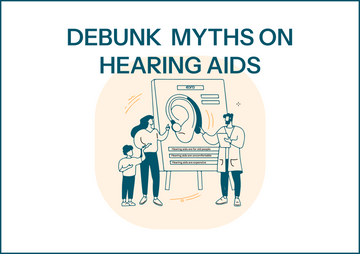Hearing aids have revolutionized the way many individuals experience sound, helping them reconnect with the world of auditory stimuli. Whether it's the laughter of a loved one, the melody of a song, or the hustle and bustle of everyday life, hearing aids play a crucial role in enhancing our auditory experience. If you've been wondering how these remarkable devices work, you're in the right place. We'll break down the complexities of hearing aids, making it easier for you to understand their functionality. Let's dive in!
What Is a Hearing Aid?
A hearing aid is a small electronic device that you wear in or behind your ear. Its main purpose is to amplify sound for individuals with hearing loss. These devices come in various styles and designs, including traditional hearing aids, Bluetooth hearing aids, and rechargeable hearing aids. Regardless of the type, all hearing aids share a common goal: improving one's ability to hear.
Basic Components of a Hearing Aid
Hearing aids contain several essential components that enable them to function effectively. Understanding these components can help demystify how they amplify sound.
1. Microphone
The microphone is the first point of contact for sound waves. It captures sounds from the environment and converts them into electrical signals. Most modern hearing aids, especially Bluetooth hearing aids, have multiple microphones to help filter and enhance sounds from various directions, ensuring clearer hearing in noisy environments.
2. Amplifier
After the microphone captures sound, the amplifier boosts the electrical signals. Hearing aids come with sophisticated sound processing technology that allows users to customize the amplification based on their level of hearing loss. This is particularly beneficial for those wearing rechargeable hearing aids, which often feature advanced settings for tailored experiences.
3. Speaker (Receiver)
The speaker, or receiver, takes the amplified electrical signals and converts them back into sound waves that reach the ear. This is where the user experiences enhanced sound quality, making conversation and enjoying audio more enjoyable.
4. Power Source
Hearing aids need power to operate. Traditional hearing aids often use disposable batteries, while rechargeable hearing aids come equipped with long-lasting batteries that can be charged overnight. This convenience eliminates the need to constantly replace batteries and ensures that your hearing aid is always ready for use!
How Do Hearing Aids Work?
Now that we’ve discussed the main components of hearing aids, let's look at how they work together to improve your hearing:
1. Sound Capture
The process starts with sound capture. The microphone picks up sounds from the environment, converting them into electrical signals. For users of Bluetooth hearing aids, this allows them to connect wirelessly to smartphones, computers, and other devices, bringing audio directly to their hearing aids.
2. Signal Processing
Once the sound is captured, it’s sent to the amplifier. Here, the hearing aid’s processor analyzes and prepares the sound signals for amplification. Advanced hearing aids can filter out background noise and enhance speech sounds, making conversations easier to follow. This is especially useful in crowded or noisy settings.
3. Amplification
The amplifier then boosts the sound signals to a level that can be easily heard by the user, allowing them to experience sounds in a way that suits their hearing needs.
4. Sound Delivery
Finally, the amplified signals are sent to the speaker, which converts them back into sound waves before delivering them into the ear. The user can enjoy the enriched sound, whether they're engaged in mundane chores or attending a lively gathering.
The Evolution of Hearing Aids
The technology behind hearing aids has evolved significantly over the years. From bulky analog devices to sleek, digital options, advancements have played a pivotal role in how hearing aids function today.
Analog vs. Digital Hearing Aids
Initially, hearing aids were predominantly analog devices. These devices simply amplified sound waves based on predetermined settings, which meant that different types of sounds were treated uniformly. This often led to feedback and distortion.
With the introduction of digital hearing aids, things changed drastically. Digital technology allows for sophisticated sound processing, meaning that different frequencies can be amplified at varying levels, providing a more natural listening experience. Users also benefit from features like noise reduction and feedback cancellation, making digital hearing aids a preferred option today.
Smart Technology Integration
In recent years, Bluetooth hearing aids have taken the market by storm. These devices allow users to connect directly to their phones, tablets, and televisions, streaming audio seamlessly. This feature is convenient for phone calls, music, or videos, making it easier for individuals to engage with the digital world.
The Benefits of Using Hearing Aids
Investing in a hearing aid, particularly with the variety of options available such as rechargeable hearing aids, can greatly impact your quality of life. Here are some notable benefits:
- Improved Communication: Hearing aids can help users to follow conversations more easily, reducing feelings of isolation and frustration.
- Enhanced Safety: By hearing environmental noises, individuals can respond to important sounds, such as traffic or alarms.
- Better Cognitive Function: Research shows that addressing hearing loss can improve cognitive function and decrease the risk of mental decline associated with age.
- Increased Engagement: Those with hearing aids are more likely to participate in social activities, boosting overall happiness and fulfillment.
Maintaining Your Hearing Aids
To ensure your hearing aids perform at their best, regular maintenance is essential. Here are some tips for keeping your hearing aids in optimal shape:
1. Regular Cleaning
Keep your hearing aids clean and free from earwax buildup. Use a soft, dry cloth to wipe them down and a brush specifically designed for hearing aids for intricate parts.
2. Battery Management
If you have traditional hearing aids, keep an eye on battery levels and replace them as needed. For rechargeable hearing aids, ensure you charge them every night to avoid running out of power during the day.
3. Safe Storage
When not in use, store your hearing aids in a safe, dry place. Some rechargeable hearing aids come with a protective case that also allows for charging, which is a great way to keep them secure.
4. Regular Check-Ups
Consult your audiologist to ensure your hearing aids are set correctly and functioning well. Regular check-ups help catch any potential issues early.
Your Hearing Matters
Understanding how hearing aids work can empower individuals with hearing loss to reclaim their auditory experiences. Options like Bluetooth hearing aids and rechargeable hearing aids make it easier to integrate these devices into daily life, improving connectivity and convenience. If you're considering a hearing aid, remember that professional advice from an audiologist can guide you toward the option that best fits your needs.
At Eara, we believe that no one should have to miss out on life's beautiful sounds. With our commitment to providing quality hearing solutions, we invite you to explore how the right hearing aid can change your life. Don't let hearing loss hold you back; instead, embrace the rich world of sound that awaits you!
Discover the joy of hearing clearly again - your auditory journey starts today!

























